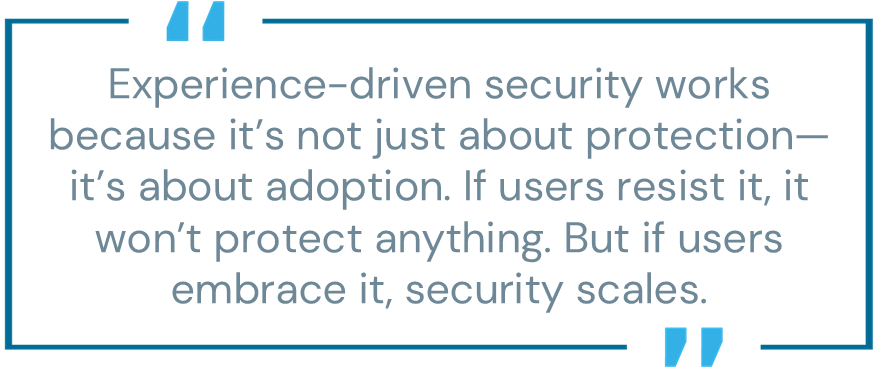
For years, cybersecurity has been chasing a future where passwords no longer exist. And yet, here we are in 2025—still resetting them, reusing them and getting breached because of them.
The reality is this: despite all the talk about passwordless authentication, we still live in a password-dependent world. Credentials remain the No. 1 attack vector. As organizations try to bridge the gap between where they are and where they want to be, they’re realizing that how users interact with passwords matters just as much as the security controls protecting them.
This situation raises an uncomfortable but necessary question: Is user experience (UX) more critical than security after all?
The answer may be yes, at least if you care about being secure.
How the Flawed UX of Passwords Poses a Security Risk
Most security vulnerabilities tied to passwords aren’t just technical; they’re human (and totally normal!). People reuse weak passwords. They write them down. They store them in spreadsheets. They share them in insecure ways. Why? Because remember and managing passwords is not just frustrating, it’s impossible.
According to CyberArk’s Employee Risk Survey, 67% of employees admitted circumventing corporate security policies to enhance productivity, engaging in risky behaviors like sending work documents to personal emails, sharing passwords and installing unauthorized applications.
That’s not negligence; that’s a system that doesn’t work for the people using it.
We’ve spent too long blaming users when security breaks down. Maybe it’s time to flip our thinking: Stop blaming the user and start designing technology that fits their behaviors. Let users lead the way.
Security leaders can no longer afford to ignore the experience layer. If the solution doesn’t work for users, they will work around it. And that’s when risk escalates.
Provide Users With a Passwordless Experience—Without Eliminating Passwords (Yet)
We may not live in a technically passwordless world (yet), but we can give users a passwordless experience—one where they never have to see, type, remember or reset a password.
This doesn’t require a wholesale shift to modern authentication protocols or overhauling every legacy app, which we all know is not a reasonable ask of any organization. It just requires making credentials invisible to users, injecting them into workflows and protecting them throughout the login and session lifecycle. That’s a passwordless experience, even if a password still exists behind the scenes.
When the experience is that seamless, users stop treating passwords as a problem to work around. And that’s when security starts to work with them, rather than against them.
Why Experience-Driven Security Works
Experience-driven security doesn’t mean compromising on controls. It means designing them so they fit naturally into people’s workflows, so they don’t have to remember dozens of passwords, manually log into unmanaged apps or find insecure shortcuts.
And when the friction disappears, so does the risk:
- No more reuse of weak credentials
- No more storing passwords in personal managers or browsers
- No more sharing over messaging platforms or email
- No more lost access when an employee leaves
At the same time, security teams gain control: they can enforce password policies, monitor credential use, restrict sharing and detect compromised credentials in real time. That’s because managing passwords is not, or should not be, an isolated function within cybersecurity. Secure authentication—passwordless or just password invisible—happens throughout the users’ digital journey, not just at login. Identity security brings together password management, single sign-on (SSO), adaptive multi-factor authentication (MFA), privileged access management (PAM) and session security in one integrated stack.
Experience-driven security works because it’s not just about protection—it’s about adoption. If users resist it, it won’t protect anything. But if users embrace it, security scales.
According to the CyberArk 2025 Identity Security Landscape, 87% of organizations experienced two or more identity-related breaches last year. Better user experiences are no longer a nice-to-have—they’re a critical line of defense.

UX First. Security Always.
If we’ve learned anything over the past decade, as both the types of access we need to secure and the kinds of attack methods have grown exponentially, effective security doesn’t happen despite a good UX—it depends on it.
Most security strategies still start with enforcement. But what if they began with empathy instead? What if we designed systems that respected how people actually work—and made security invisible enough to be effective?
A great UX doesn’t weaken security—it’s enabled by it. And the more we accept that reality, the more secure—and productive—our organizations can become.
Maybe it’s time to stop forcing users to do more and start helping them do less. Giving users simpler, safer access reduces risky behaviors, closes the gaps that attackers exploit, and can help businesses scale secure access without slowing down their people.
So maybe the best way to secure your workforce isn’t just to upgrade your security controls. Maybe it’s time to upgrade your UX, too.
Laura Balboni is a senior product marketing manager at CyberArk.






















